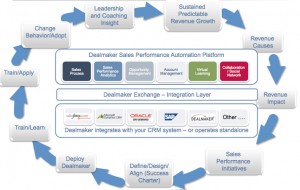Improving revenue performance is a never-ending challenge for sales organization. Just ask those organizations that keep monthly targets, rather than quarterly ones. The pressure is relentless. Time takes no break for the holidays, and we all need to catch our breath once in a while.
It’s the same with managing change. Sales effectiveness is about managing change, about managing changes in behavior. And since we’re constantly looking to improve revenue performance, it means we’re constantly looking to improve the effectiveness of our sales organization, which means we should be constantly helping to shape the optimal sales behaviors of our people.
It’s hard, because it’s a challenge you can never put to bed. This is why thinking of sales effectiveness as some kind of project, with a start and finish line that you can plot on a Gantt chart, is flawed. Sales effectiveness is the never ending circle, because once you’ve finished something, you look back at the lessons you learned and make some changes to the next iteration. If you’re in sales, from your customer’s point of view the flow is pretty much like this (I know this list has a start and a finish too, but please do imagine it as a circle):
1. Assessing problems and opportunities
2. Defining needs and objectives
3. Visualizing solutions
4. Evaluating alternatives
5. Negotiating terms
6. Purchasing something
7. Implementing it
8. Learning the new stuff
9. Applying it
10. Measuring
11. Coaching, tweaking, improving
12. Re-evaluating, and starting over
For the selling organization, the flow should be mapped where possible to the buyer’s flow:
1. Prospecting, generating demand, account planning
2. Qualifying
3. Developing requirements
4. Demonstrating proof
5. Negotiating acquisition
6. Processing the order
7. Deploying
8. Enabling
9. Instructing
10. Measuring
11. Reviewing
12. Managing, and starting over
Marrying these 2 circles is a third circle, that we at The TAS Group use as a template for our customers to work with their customers to bring about sustained revenue performance. Even if you don’t end up working with us and investing in Dealmaker, which is the physical manifestation of the template, we think it’s a pretty good template for you to use and build from yourselves, so please use it with our blessing.
In the beginning, your customers have a problem, and that problem is revenue-related, since everything that a commercial enterprise does boils down to revenues in and costs out. The revenue problem might be a question of sustaining revenue, revenue shortfall, needing to do more with less, or finding an extra 10% with the same resources. It also might center on the effectiveness and performance of the selling organization and its management. Perhaps it’s the sheer unpredictability of the revenue pattern, due to inaccurate or ponderous sales forecasting. All of these problems have a root cause, which bring a knock-on impact to the company, such as poor productivity, high customer or sales staff turnover, low morale and so on. In order to address the problems, through an understanding of the causes and impacts, companies need to find solutions, or sales initiatives, to right the ship.
Your customers often need your help as subject matter experts in exploring and uncovering the way forward, and you certainly won’t find out about them unless you’re involved. This is where you collaborate with your customer and find the way forward together. We use the Dealmaker Collaboration Map [http://www.thetasgroup.com/dealmakerplatform.html] to map out the problem-cause-impact-solution journey. At the end of it your customer has identified some sales performance initiatives to address their challenges. From this point they define the initiative in more detail, design what success looks like for it, and align all the stakeholders to the direction. We use our Success Charter to build on the outputs of the Collaboration Map and cement the parameters of a successful sales initiative.
After the aligning and communicating with their stakeholders, then is the time for your customers to roll out your initiative, implementing the solution, training their people, getting them to apply the knowledge until the change of behavior becomes ingrained and they can be said to have adopted the changes. Finally, they need to measure the behavior changes, coach to the right behavior, and, with a successful initiative, reap the benefits on a continuous basis. But they’ll still have problems and challenges (or issues and drivers to use ‘kinder’ terms), that need working on with you to find better ways of working. And so the circle continues.
If you see sales effectiveness as a circular line, and not a straight line, you’ll always be on the right line.




